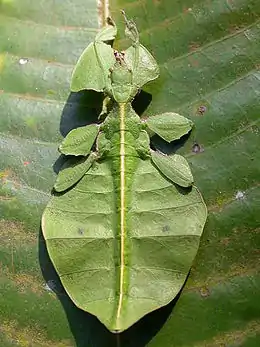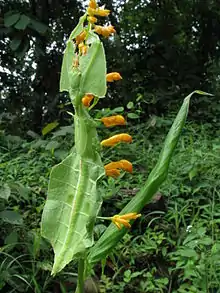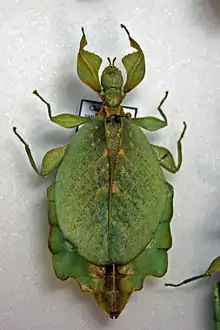Phylliidae
The family Phylliidae (often misspelled Phyllidae) contains the extant true leaf insects or walking leaves, which include some of the most remarkably camouflaged leaf mimics (mimesis) in the entire animal kingdom. They occur from South Asia through Southeast Asia to Australia. Earlier sources treat Phylliidae as a much larger taxon, containing genera in what are presently considered to be several different families.[1]
| Leaf insects Temporal range: Eocene - Recent | |
|---|---|
 | |
| Phyllium from the Western Ghats | |
| Scientific classification | |
| Kingdom: | Animalia |
| Phylum: | Arthropoda |
| Class: | Insecta |
| Order: | Phasmatodea |
| Infraorder: | Areolatae |
| Family: | Phylliidae Redtenbacher, 1906 |
| Genera | |
|
see text | |
Characteristics
Leaf insects are camouflaged taking on the appearance of leaves. They do this so accurately that predators often are not able to distinguish them from real leaves. In some species the edge of the leaf insect's body even has the appearance of bite marks. To further confuse predators, when the leaf insect walks, it rocks back and forth, to mimic a real leaf being blown by the wind.[2]

The scholar Antonio Pigafetta probably was the first Western person to document the creature. Sailing with Ferdinand Magellan's circumnavigational expedition, he studied and chronicled the fauna on the island of Cimbonbon as the fleet hauled ashore for repairs. During this time he documented the Phyllium species with the following passage:[3]
Tribes, Genera and Species
The Phasmida Species File (V. 5.0) lists the following in two tribes:[5]
Nanophylliini
Distribution: Australasia, New Guinea; auth. Zompro & Grösser, 2003
- Nanophyllium Redtenbacher, 1906
- Nanophyllium adisi Zompro & Grösser, 2003
- Nanophyllium hasenpuschi Brock & Grösser, 2008
- Nanophyllium pygmaeum Redtenbacher, 1906
- Nanophyllium rentzi Brock & Grösser, 2008
- Nanophyllium asekiense Grösser, 2002
- Nanophyllium frondosum Redtenbacher, 1906
Phylliini
Distribution: Australasia, Asia, Pacific; auth. Brunner, 1893

- Chitoniscus Stål, 1875 (Australasia)
- Chitoniscus brachysoma Sharp, 1898
- Chitoniscus erosus Redtenbacher, 1906
- Chitoniscus feejeeanus Westwood, 1864
- Chitoniscus lobipes Redtenbacher, 1906
- Chitoniscus lobiventris Blanchard, 1853
- Chitoniscus sarrameaensis Grösser, 2008
- Microphyllium Zompro, 2001 (Philippines)
- Microphyllium haskelli Cumming, 2017
- Microphyllium pusillulum (Rehn & Rehn, 1934)
- Microphyllium spinithorax Zompro, 2001

- Phyllium Illiger, 1798 (Australasia, Asia, Pacific).
Selected species:- Phyllium athanysus Westwood, 1859
- Phyllium bioculatum Gray, R.G., 1832
- Phyllium bilobatum Gray, R.G., 1843
- Phyllium brevipenne Grösser, 1992
- Phyllium geryon Gray, 1843
- Phyllium giganteum Hausleithner, 1984
- Phyllium hausleithneri Brock], 1999
- Phyllium jacobsoni Rehn, J.A.G. & Rehn, J.W.H., 1934
- Phyllium siccifolium (Linnaeus, 1758)
- Phyllium westwoodii Wood-Mason, 1875
- Pseudomicrophyllium Cumming, 2017 (North Luzon, monotypic genus)
- Pseudomicrophyllium faulkneri Cumming, 2017
- Phyllium letiranti Cumming & Teemsma, 2018
Extinct species
A 47-million-year-old fossil of Eophyllium messelensis, a prehistoric ancestor of Phylliidae, displays many of the same characteristics of modern leaf insects, indicating that this family has changed little over time.[6]
References
- Bradley, J.C.; Galil, B.S. (1977). "The taxonomic arrangement of the Phasmatodea with keys to the subfamilies and tribes". Proceedings of the Entomological Society of Washington. 79 (2): 176–208.
- Hidden Beauty (Archived)
- Bergreen, Laurence (2003). Over the Edge of the World: Magellan's Terrifying Circumnavigation of the Globe. William Morrow. ISBN 0-06-621173-5.
- Pigafetta, Antonio. "Anthony Pigapheta, Patrician of Vincenza, and King of Rhodes, to the very illustrious and very excellent Lord Philip de Villers Lisleaden, the famous Grand Master of Rhodes, his most respected Lord." Alderley, Lord Stanley of. The First Voyage Round the World, by Magellan. New York: Burt Franklin, n.d. 35-163.
- Phasmida Species File (Version 5.0/5.0): Phylliidae
- Wedmann, Sonja; Bradler, Sven; Rust, Jes (9 January 2007). "The first fossil leaf insect: 47 million years of specialized cryptic morphology and behavior". Proceedings of the National Academy of Sciences. 104 (2): 565–9. doi:10.1073/pnas.0606937104. PMC 1766425. PMID 17197423. Retrieved 2007-01-15.
External links
 Media related to Phylliidae at Wikimedia Commons
Media related to Phylliidae at Wikimedia Commons- Phasmid Study Group: Phylliidae